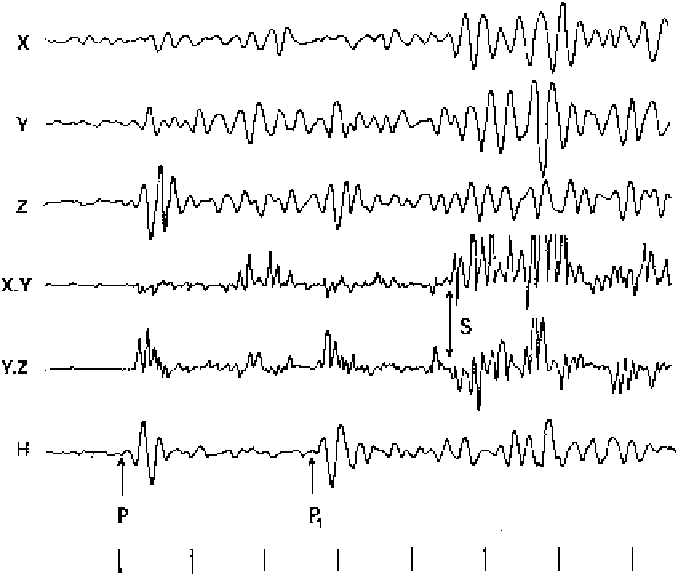Geoscience Reference
In-Depth Information
Figure 9.23.
A record
from an ocean-bottom
seismometer (OBS) of an
explosive charge 33 km
away and on the opposite
side of the axis of the
Mid-Atlantic Ridge. X and
Y (horizontal) and Z
(vertical) denote
seismometer
components; H,
hydrophone; time marks
every second; X.Y
(product of X and Y) and
Y. Z (product of Y and Z)
are displayed with a
smaller scaling factor than
X, Y and Z. P is the
first-arriving P-wave; it
has crossed the ridge axis
in the lower part of layer
3; P
1
is the sea-surface
(multiple) reflection of P;
Sisthe first-arriving shear
wave, which has also
crossed the ridge axis in
the lower crust. The
arrival time of the shear
wave can be picked most
accurately from the
products X.Y and Y.Z.
(From Fowler (1976).)
However, results of detailed seismic and electromagnetic experiments at 57
◦
N
on the Reykjanes Ridge have delineated a significant crustal magma body: a lens
of very-low-velocity material is present 2-3 km below the axial volcanic ridge.
This lens, which is about 3 km across and 200 m thick, has a P-wave velocity
of 3.3 km s
−
1
. Either side of the ridge axis the P-wave velocity at this depth
is 6.5 km s
−
1
,which corresponds to the top of layer 3. Immediately above and
below the lens the layer-2 and -3 velocities are 1.0-1.5 km s
−
1
lower than off-axis
velocities at comparable depths. By 10 km from the ridge axis the crust is a normal
7km thick and is underlain by a normal Moho. Results of electrical-resistivity
studies delineate a small body with a very low resistivity (0.2
m) coincident
with the seismic low-velocity zone. Such resistivity values are appropriate for a
basaltic melt. The location for these experiments was carefully chosen to be on
a magmatically active section of the Reykjanes Ridge. It seems therefore that,
during the most magmatic time of their tectono-magmatic cycle (Section 9.4.1),
short-lived, transient melt bodies can be expected to underlie the axes of slow-
spreading ridge segments.
Seismic wide-angle and normal-incidence experiments have imaged a melt
body along at least 50 km of the axis of the Valu Fa Ridge in the Lau back-
arc basin (half-spreading rate 3 cm yr
−
1
). There the magma chamber is at most
4km wide and extends from 2.9 km below the seabed, through layer 3 to within

